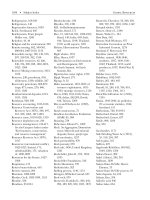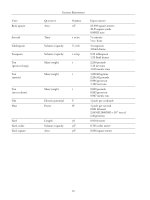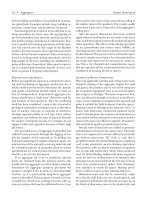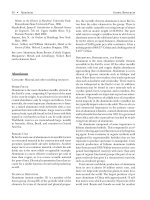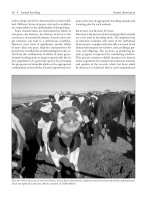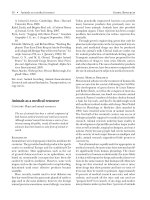Encyclopedia of Global Resources part 37 pptx
Bạn đang xem bản rút gọn của tài liệu. Xem và tải ngay bản đầy đủ của tài liệu tại đây (328.71 KB, 10 trang )
evolutionary history, developmental processes, and
behavioral adaptations and interactions of organisms
from all over the world for the purpose of studying
biodiversity. This type of study operates mainly at the
levels of population, species, and communities and
utilizes many subsets of ecology. Scientists employ pa-
leoecology to establish historic patterns of biodiver-
sity; genetic ecology, especially DNA techniques, to
study variationand tomake genealogicalconnections
among organisms; telemetry and satellites to study
patterns in distribution of various species; and com-
puter simulations and field experimentation to test
out hypotheses. Both genetic and evolutionary ecol-
ogy are important for theconservation of biodiversity
and for developing applications to solve biological
problems.
Applied Ecology
Ecology also involves many aspects of applied science
in which the results of scientific study are applied to
real-life situations, from natural resource manage-
ment to urban planning. Biotic natural resources
have been managed at the individual and population
levels since the agricultural revolution occurred eight
thousand to ten thousand years ago. Until the 1960’s,
forestry, fish, and wildlife management techniques
were aimed at increasing the productivity of single
species—usually game species, such as quail and trout,
or commercial tree species, such as loblolly pine. As
community ecology and ecosystem ecology matured,
and as popular concern for the loss of species arose
in the 1960’s, natural resource management agen-
cies began to look at the effects of single-species man-
agement techniques on the entire community. Range
management has always taken the community ecology
perspective in managing native grass and shrub com-
munities for livestock forage production. However,
range conservationists also manage forage produc-
tion for wildlife as well as for livestock. Conservation
biology applies the understanding of all ecological
levels in the attempt to prevent species extinction, to
maintain species genetic diversity, and to restore self-
sustaining populations of rare species or entire com-
munities.
Population ecology remains the core of these ap-
plied ecological disciplines. Population ecologymainly
deals with mortality rates, birthrates, and migration
into and out of local populations. These are the biotic
factors that influence population size and productiv
-
ity. The goal of consumptive natural resource man
-
agement is the harvesting of population or community
productivity. The goal of nonconsumptive natural
resource management is to manage for natural aes-
thetic beauty, for the maintenance of diverse commu-
nities, for the stability of communities and ecosystems,
and for a global environment that retains regional bi-
otic processes.
Issues in Ecology
Among the applications of ecological studies are some
of the following:
• climate change; and global warming;
• loss of species populations and concomitant loss
of biodiversity, including threatened species and
endangered species (such as the collapse of bee
colonies important for pollination) and the intro-
duction of exotic invasive species into unnatural
habitats;
• changes in global ocean currents and their effect
on terrestrial biomes such as forests and deserts;
• human activities, including the release of pollut-
ants and their impact on the food chain and animal
species, and global resource consumption levels
and their impact on ecosystems, land conversion
and habitat loss, infrastructure development, and
overexploitation;
• blockage of solar energy and holes in the ozone
layer; and
• the potential impact of space debris on the global
environment.
Internationally, environmental scientists and oth-
ers are entering into treaties, conducting serious dis-
cussions at global conferences, and collaborating on
solutions to resolve these and many other issues—
including the availability of food and other re-
sources—that may affect future survival. Making hu-
mans aware of the many ecological concerns and
gaining their support in protecting, conserving, and
preserving the environment and global resources for
future generations, thus enhancing the health of the
Earth, may be the most important goal of the study of
ecology.
James F. Fowler, updated by Carol A. Rolf
Further Reading
Bertorelle, Giorgio, etal. PopulationGenetics for Animal
Conservation. New York: Cambridge University
Press, 2009.
330 • Ecology Global Resources
Cain, Michael L., William D. Bowman, and Sally D.
Hacker. Ecology. Sunderland, Mass.: Sinauer Associ-
ates, 2008.
Morin, Peter Jay. Community Ecology. 2d ed. Oxford,
Oxfordshire, England: Blackwell, 2008.
Sherratt, Thomas N., and David M. Wilkinson. Big
Questions in Ecology and Evolution. New York:Oxford
University Press, 2009.
Weisman, Alan. The World Without Us. New York: Pica-
dor, 2008.
Web Sites
Cell Press
Trends in Ecology and Evolution
/>Ecology Global Network
/>The Global Education Project
/>global-ecology.php
See also: Aggregates; Conservation biology; Deep
ecology; Ecosystems; Ecozones and biogeographic
realms; Fisheries; Food chain; Forest management;
Overgrazing; Species loss; Wildlife; Wildlife biology.
Ecosystem services
Category: Ecological resources
Ecosystem services are the means by which societal ben-
efits and supportare provided by ecosystems. Such ben-
efits and support are also known as natural capital.
They include climate regulation, water availability,
the maintenance of wildlife and their habitats, fodder,
and the production of raw materials such as wood, fi-
ber, medicines, and a range of foods. All are funda-
mental components in people-environment relation-
ships, given their necessity for human well-being, and
all contribute to the provision and/or maintenance of
global resources.
Background
Ecosystem services are closely linked with biogeochem-
ical cycles and energy transfer. In biogeochemical cy
-
cles nutrients are continuously transferred between
the constituent parts of the Earth’s surface: rocks,
soils, water (freshwater and marine), plants, animals,
and the atmosphere. These processes are vital in en-
ergy transfers within food chains and webs. The spa-
tial and temporal distribution of these processes is de-
termined to a large extent by climatic characteristics
but also influences global climate via the carbon cycle.
Such processes affect the quality of the “commons”
(air, water, oceans), the maintenance of which is es-
sential to human well-being. These processes also
control the natural capital that accrues within all eco-
systems and that is used for society’s needs. Ecosystem
services underpin all human activity through the con-
tinuous generation of resources and the environmen-
tal processes that are essential to that generation. In-
evitably, ecosystem services are complex, are under
pressure from a growing global population, and re-
quire careful management. The Millennium Ecosystem
Assessment (MEA), compiled as a collaborative effort
by 1,360 scientists worldwide between 2001 and 2005,
summarizes the state of and major trends in global
ecosystems and their services under the four headings
used below.
Supporting Services
The primary supporting services are nutrient cycling,
soil formation, and primary production. Nutrient, or
biogeochemical, cycling involves the transfer of ele-
ments and compounds within and between the bio-
sphere (organisms and their environment), atmo-
sphere, and pedosphere (soils). They consist of pools
or stores between which fluxes occur. For example, in
the carbon cycle the major pools are living organisms,
dead organic matter, the oceans, and the atmosphere.
Fluxes occur between these pools at rates that vary ac-
cording to factors such as climate. Nutrient cycles also
link the inorganic and organic components of the en-
vironment and operate at various spatial and tempo-
ral scales. For example, photosynthesis, respiration,
and decomposition link microbes, plants, and ani-
mals with water, soils, and the atmosphere through
carbon, hydrogen, nitrogen, phosphorus, and many
other elemental cycles. Most major nutrients—carbon
is the most obvious example—have a pool in the at-
mosphere and are thus an influence on climate. These
are gaseous biogeochemical cycles. Those nutrients
without an atmospheric pool—for example, phos-
phorus, iron, and calcium—are sedimentary biogeo-
chemical cycles.
Soil formation involves the breakdown of solid
bedrock into small particles by biological, chemical,
Global Resources Ecosystem services • 331
and physical processes known collectively as weather
-
ing. Dead organic matter from microbes, insects, and
pioneer plants is mixed with the particles to create
new habitats for organisms; this aids water retention,
which continues the weathering process and con-
tributes to the release of nutrients for use by plants.
Many factors—the most important being climate—
influence the processes and rates of soil formation,
water availability, and degree of acidity or alkalinity.
Primary production is the amount of organic mat-
ter produced per unit area per unit time by organisms
that can photosynthesize (green plants on land and
algae in the oceans). These organisms have the ability
to absorb solar energy and convert it to chemical en-
ergy through the generation of complex organic com-
pounds such as sugars and carbohydrates. Although
less than 1 percent of the solar energy that reaches
Earth is used in photosynthesis, this small amount fu-
els the biosphere. Primary production is the first stage
in energy transfer through ecosystems and is thus the
basis of all food chains and webs. All animals, includ-
ing humans, depend on primary production for sur-
vival—not only for food and shelter but also for a wide
range of goods, including fiber, wood, and medicine.
Rates of primary production (primary productivity)
are influenced by environmental factors such as water
availability, annual temperature regimes, soil types,
and nutrient availability. Nutrient cycling, soil forma-
tion, and primary production are vital for the ecosys-
tem services described below.
Provisioning Services
Provisioning services encompass food, wood, fiber,
genetic resources, fuel, and fresh water. Primary pro-
duction on land and in the oceans underpins the gen-
eration and replenishment of many resources on
which humanity depends. Apart from fossil fuels,
these are all renewable resources and are all organic
or biological in origin. The provision of fresh water is
renewable but is inorganic in essence, though influ-
enced by ecosystem (biological) characteristics.
Global food production is a vast enterprise that es-
sentially processes carbon and is a major generator of
wealth. It involves crop and animal agriculture at vari-
ous scales (subsistent or commercial); may have a fos-
sil-fuel subsidy, as in the case of “industrialized” agri-
culture; and requires a reliable supply of fresh water.
An indication of the magnitude of this production is
reflected in the Food and Agriculture Organization’s
(FAO’s) 2006 data for the major staple crops: 695 mil
-
lion metric tons of maize, 634 million metric tons of
rice, and 605 million metric tons of wheat. A propor-
tion of this is used as animal feed to create secondary
productivity such as meat and milk products. These
and other crops, including cotton fiber, are produced
on about 15 million square kilometers of cropland.
An increasing proportion of crop production—
notably that of corn, soybean, and canola—is used to
generate biofuels, while several crops are grown spe-
cifically as biofuels. However, the value of growing ma-
terials to use as biofuels is controversial because the
crops take up land that could be used for food produc-
tion. An additional roughly 28 million square kilome-
ters of pasture support a large proportion of the
world’s cattle and sheep. Cotton is the world’s major
fiber; about 25 million metric tons were produced in
2005.
Fish derived from inland and marine waters form
an important component of human diets. According
to FAO statistics, some 141.4 million metric tons of
fish were produced in 2005, about 35 percent of
which was from inland waters, where aquaculture pre-
dominates, and about 65 percent of which was from
marine waters, where the harvesting of wild popula-
tions is predominant. Some 97 percent of this is con-
sumed directly by humans; the remainder is pro-
cessed for animal feed. However, the global fishing
industry is facing problems because fish stocks have
been seriously depleted. The reduction or loss of this
service illustrates the difficulties that arise when con-
servation and management are inadequate: Marine
ecosystems are altered and social consequences arise.
The world’s natural forests and plantations are an-
other major resource with a host of uses, the most im-
portant of which are as materials for construction,
furniture, fencing, pulp and paper, garden products,
and fuel. Forests are also a source of nonwood re-
sources, including nuts, berries, fodder, and game. In
2007, about 3.6 billion cubic meters of roundwood
was produced globally. The chief producers were
India, China, the United States, Brazil, and Canada.
The proportion removed for wood fuel is unknown.
However, the loss of forest cover because of agricul-
ture, logging, and poor management reduces the
capacity of the terrestrial biosphere to store carbon.
FAO indicates that between 1990 and 2005 carbon
stocks in forest biomass decreased by 1.1 billion met-
ric tons of carbon annually; this reflects impairment
of an ecosystem service.
The organisms in the world’s ecosystems contain a
332 • Ecosystem services Global Resources
wealth of genetic resources with vast potential. Biodi
-
versity prospecting is the term given to programs de-
signed to tap this resource by identifying species and
screening them foruseful properties such as crop pro-
tection chemicals and pharmaceuticals.About 25 per-
cent of prescription medicines are plant based, in-
cluding the widely used aspirin, while the bacterium
Bacillus thuringiensis is the basis of insect pest control
in a range of crops. The bacterium itself is produced
as a commercial spray, but the gene component re-
sponsible for insect mortality has been identified and
inserted into a number of crops, notably cotton and
maize, so that these geneticallymodified varieties pro-
duce their own insecticide. Asfurtheradvances in bio-
technology and genetic modification ensue, further
opportunities to harness genetic resources will arise.
Fossil fuels are also generated through primary
productivity but relate to geological eras many mil-
lions of years in the past, when the carbon cycle in-
volved the storage or sequestration of huge volumes
of plant-based carbon in reservoirs that eventually be-
came rocks. For example, coal formed in wetlands,
and limestone formed in the oceans. These processes
continue to operate but at such slow rates that fossil
fuels cannot be considered renewable.
Fresh water, a vital resource for human well-being,
is renewable. It is a component of the hydrological
cycle, a fundamental facilitating factor in ecosystem
and society functioning. Water from precipitation
reaches the Earth’s surface and its subsequent pas-
sage depends largelyon how evaporation, recharge of
groundwater reservoirs, and runoff are affected by
the ecosystems through which it passes. Forest and
mountain ecosystems are especially important in this
context, accounting for about 85 percent of total run-
off, which supports approximately 4 billion of the
world’s estimated 6.7 billion people. Cultivated land
accounts for most of the remainder. Wetlands are also
important as water storesand hydrological regulators.
Regulating Services
Climate, flood, and disease regulation, water purifica-
tion, and pollination are major regulating services.
Climate and the Earth’s ecosystems have been inter-
dependent throughout geologic time; the major link
between the two is the global carbon cycle, though
other biogeochemical cycles are also involved. This
mutual development has manifested in various ways
but is especially significant in termsof global tempera
-
ture regimes and atmospheric composition.
The Earth and its atmosphere form a closed sys
-
tem, or nearly so, in terms of chemical constitution.
The redistribution of atoms and molecules between
the Earth’s core, lithosphere, biosphere, and atmo-
sphere has been, and continues to be, mediated by
life-forms onland and in the oceans.Overall, this rela-
tionship has maintained life in the biosphere and
helped to spur evolution. It also has caused major
shifts in the carbon cycle as carbon is removed from
the atmosphere into the biosphere and, eventually,
the lithosphere. The evolution of photosynthesis, for
example, was particularly important because it not
only fixed carbon from the atmosphere but also re-
leased oxygen, paving the way for the evolution of
mammals, including humans.
Beginning with the Industrial Revolution, humans
began to alter the carbon cycle profoundly through
fossil-fuel consumption and deforestation. Evidence
indicates that these may contribute to global warm-
ing. The speed of the alteration in the carbon cycle
is more rapid than the gradual processes that charac-
terize the geological past; thus, concerns about seri-
ous consequences for human well-being seem to be
justified.
Flood regulation is a function of all ecosystems but
is most important in forests, grasslands, and wetlands.
Following receipt of high rainfall or snowfall such eco-
systems store water in the vegetation and soils and
temper its release togroundwater, streams, and rivers.
This reduces the impact of floodwaters on ecosystems
and society in built-up areas like river valleys, estuar-
ies, and deltas. Degradation of upstream ecosystems
can impair this capacity and imperils millions of peo-
ple. Erosion control is also linked with the preserva-
tion of an adequate vegetation cover in river catch-
ments and safeguards downstream land use and
settlements. The passage of water through ecosys-
tems—in which vegetation, microorganisms, and soils
act as filters—contributes to water purification. Pol-
lutants such as metals, excess nutrients such as nitro-
gen, and sediments are removed, which improves
conditions for downstream ecosystems and land use.
Many diseases experienced by crops and animals
(including humans) are influenced by ecosystem di-
versity; pest and disease outbreaks are not likely in
biodiverse regions because the passage of viruses is
made difficult by the buffering capacity of non-host
species. The natural control of vectors is also en
-
hanced with high biodiversity.
Pollination is another vital ecosystem service. It fa
-
Global Resources Ecosystem services • 333
cilitates the sexual reproduction of many plants, in
-
cluding crops, with genetically diverse offspring as a
result. Without such fertilization, fruiting would not
occur. Many animal species—bats, birds, and insects
such as bees, butterflies, flies, moths, and beetles—
are involved in pollination. About 33 percent of hu-
man food production depends on these wild pollina-
tors; thus, the service is of economic importance.
Cultural Services
Cultural services—aesthetic, spiritual, educational,
and recreational—do not provide immediately tangi-
ble resources akin to food, for example, but they con-
tribute to human well-being in many ways. Further-
more, in the context of education, they may improve
understanding of ecosystem form and function and
contribute to sustainable management strategies. Dis-
tinct types ofecosystem provide a sense of place, influ-
ence culture, inspire art forms, and are important
in many religions. Wealth generation—through the
value of landscape, wildlife, and recreation—is an-
other cultural ecosystem service. Other forms of em-
ployment, such as forestry, conservation, and man-
agement, also contribute to wealth generation.
Future Context
Global population is estimated to increase to 8 billion
by 2030. This will compound pressure on already
stretched ecosystem services and require an increase
in food production by at least 25 percent. According
to the MEA, humans have altered global ecosystems
more substantially since the mid-twentieth century
than at any other time in history. This happened be-
cause of a threefold growth in population, rapid con-
version of forests and grasslands to agricultural land,
technologies such as automobiles requiring fossil fu-
els, and rising standards of living that encompass in-
creased resource use. More than half of the services
provided are being degraded mostly at the expense of
the poorest people. One aspect of this degradation is
the high rate of plant and animal extinction such as
the loss of genetic resources, a process that, unlike
many other environmental problems, is irreversible.
Unsustainable practices and resulting inequity require
immediate attention from local, national, and inter-
national political and environmental institutions. Each
requires the inventoryand valuationof ecosystem ser-
vices, monitoring, investment in management, educa
-
tion programs, and cooperation at all scales.
A. M. Mannion
Further Reading
Botkin, Daniel B., and Edward A. Keller. Environmen-
tal Science: Earth as aLiving Planet. 7th ed.New York:
John Wiley & Sons, 2009.
Mannion, Antoinette M. Carbon and Its Domestication.
Dordrecht, Netherlands: Springer, 2006.
Melillo, Jerry, and Osvaldo Sala. “Ecosystem Ser-
vices.” In Sustaining Life: How Human Health De-
pends on Biodiversity, edited by Eric Chivian and
Aaron Bernstein. New York: Oxford University
Press, 2008.
Ninan, K. N., ed. Conserving and Valuing Ecosystem Ser-
vices and Biodiversity: Economic, Institutional and So-
cial Challenges. Sterling, Va.: Earthscan, 2008.
Web Sites
Food and Agriculture Organization of the
United Nations
FAOSTAT
/>Millennium Ecosystem Assessment
Millennium Assessment 2009
/>index.aspx
See also: Agriculture industry; Biosphere; Carbon cy-
cle; Ecology; Ecosystems; Ecozones and biogeo-
graphic realms; Fisheries; Geochemical cycles; Green-
house gases and global climate change; Hydrology
and the hydrologic cycle; Natural capital; Nitrogen
cycle; Phosphorus cycle.
Ecosystems
Category: Ecological resources
An ecosystem is formed by the complex interactions of a
community of individual organisms of different spe-
cies with one another and with their abiotic (nonliv-
ing) environment.
Background
A biological community consists of a mixture of popu-
lations of individual species; a population consists of
potentially interbreeding members of a species. Indi
-
vidual organisms interact with members of their own
species as well as with other species. An ecosystem is
334 • Ecosystems Global Resources
formed by this web of interactions among species
along with the physical, chemical, and climatic condi-
tions of the area.
Abiotic environmental conditions include temper-
ature, water availability, soil nutrient content, and
many other factors that depend on the climate, soil,
and geology of an area. Living organisms can alter
their environment to some degree. A canopy formed
by large forest trees, for example, will change the
light, temperature, and moisture available to herba-
ceous plants growing near the forest floor. The envi-
ronmental conditions in a particular area can also be
affected by the conditions of neighboring areas; the
disturbance of a stream bank can lead to erosion,
which will affectaquatic habitat for a considerabledis-
tance downstream. It can be difficult to anticipate the
wide-ranging affects of ecosystem disturbance.
Species and individuals within an ecosystem may
interact directly with one another through the ex
-
change of energy and material. Predators, for exam
-
ple, obtain their energy and nutritional needs through
consumption of prey species. Organisms also interact
indirectly through modification of their surrounding
environment. Earthworms modify soil structure phys-
ically, affecting aeration and the transport of water
through the soil. In turn,these alterationsof thephys-
ical environment affectroot growth and development
as well as the ability of plants to secure nutrients.
Ecosystems are not closed systems: Energy and ma-
terial are transferred to and from neighboring sys-
tems. The flow of energy or material between the
components of an ecosystem, and exchanges with
neighboring ecosystems, are governedby functions of
the abiotic and biotic ecosystem components. These
ecological processes operate simultaneously at many
different temporal and spatial scales. At the same time
that a microorganism is consuming a fallen leaf, the
process of soil formation is occurring through chemi
-
cal and physical weathering of parent material; plants
are competing with one another for light, water, and
Global Resources Ecosystems • 335
Taiga, featuring coniferous forests and located in the northern portion of the Northern Hemisphere, is one type of ecosystem. (©Irina
Bekulova/Dreamstime.com)
nutrients; and weather may be changing—a storm
front, for example, may be approaching.
Ecosystem Boundaries and Temporal Scales
Because of the exchange of energy and material, it is
not possible to draw clear boundaries around an eco-
system. A watershed is formed by topographic condi-
tions forming physical barriers guiding the gravita-
tional flow of water, yet wind carries seeds and pollen
over these barriers, and animals can still move from
watershed to watershed. The strength of the interac-
tions among neighboring systems is the basis on which
humans delineate ecosystem boundaries. In truth, all
ecosystems around the world interact with one an-
other to some degree or another.
Ecological processes operate at many different
timescales. Some operate over such long timescales
that they are almost imperceptible to human observa-
tion. The process of soil formation occurs over many
human life spans. Other processes operate over ex-
tremely short time intervals. The reproduction of soil
bacteria, the response of leaves to changing tempera-
ture over the length of a day, and the time required for
chemical reactions in the soil are all very short when
compared to a human life span. Usually the timescale
of a process is related to its spatial scale; processes that
operate at short timescales also tend to operate over
short distances.
Ecosystem Disturbance
Ecosystems are subject to disturbance, or perturba-
tion, when one ormore ecosystem processes are inter-
rupted. Disturbance is a natural ecological process,
and the character of many ecosystems is shaped by
natural disturbance patterns. The successful repro-
duction of many prairie species may be dependent on
336 • Ecosystems Global Resources
Gazelles graze on an African savanna, one type of ecosystem. (©Birute Vijeikiene/Dreamstime.com)
periodic fire. Suppression of fire as a means of pro
-
tecting an ecosystem may lead to the local extinction
of small plants, which depend on periodic fires to in-
crease light availability by removing larger grasses and
providing nutrients to the soil. The formationof sand-
bars in streams may be controlled by periodic flood
events that remove great amounts of sediment from
stream banks. Protection of existing ecosystems can
depend on the protection or simulation of natural dis-
turbances. This is even true of old-growth forests; the
natural disturbance interval due to fire or windstorm
may be centuries, and yet interruption of the natural
disturbance pattern may lead to shifts in species com-
position or productivity.
Increasing the frequency of disturbance can also
affect ecosystem structure and function. Repeated
vegetation removal will favor species that take advan-
tage of early-successionalconditions atthe expenseof
species that are more adapted to late-successional
conditions. In order to ensure continued functioning
of ecosystem processes and the survival of all species,
it is necessary to have a mix of systems in early-
successional and late-successional stages in a land-
scape. Human resource utilization must be managed
within this context in order to ensure the long-term
sustainability of all ecosystem components and to re-
duce the chances of extinction of some species be-
cause of human alteration of natural disturbance in-
tervals.
Ecosystem Stability
A system is stable if it can return to its previous condi-
tion at some time after disturbance. The length of
time required to return to the original condition is
the recovery time. Stability is an important property
of ecosystems that are utilized by humans. The recov-
ery of fish populations,the reestablishment of a forest
following harvesting, and the renewed production of
forage following grazing all depend on the inherent
stability of the affected ecosystem. The stability of an
ecosystem is dependent on its components and their
interrelationships. Disturbance may primarily affect
one component of an ecosystem, as with salmon fish-
ing in the Pacific Ocean. The ability of the entire eco-
system to adjust to this disturbance depends on the
complexities of the interrelationships between the sal-
mon, their predators and prey, and their competitors.
The length of the recovery time varies with the type
of system, the naturaldisturbance interval,and the se
-
verity of the disturbance. The population of algae
along the bottom of a streambed may be severely dis
-
turbed by spring flooding, yet may be resilient and re-
turn toits pre-disturbance condition in a short time.A
forest containing one-thousand-year-old mature trees
may be extremely resilient and able eventually to rees-
tablish itself following a windstorm or harvesting, but
the recovery time extends over many human life-
times.
There are species thatrequire disturbance in order
to regenerate themselves. These species may be pres-
ent in great abundance following a disturbance. Their
abundance then decreases over time, and if there is
no disturbance to renew the population, they will
eventually die out and no longer be present in the
ecosystem.
A system is usually stable only within some bounds.
If disturbed beyond these recovery limits the system
may not return to its previous state but may settle into
a new equilibrium. There are examples in the Medi-
terranean region of systems that were overgrazed in
ancient times and that have never returned to their
previous species composition and productivity. Forest
managers, farmers, fishermen, and others must un-
derstand the natural resiliency of the systems within
which they work and stay within the bounds of stability
in order to ensure sustainable resource utilization
into the future.
Matter and Energy Cycles
Ecological processes work through the cycling of mat-
ter and energy within the system. Nutrient cycling
consists of the uptake of nutrients from the soil and
the transfer of these nutrients through plants, herbi-
vores, and predators until their eventual return to the
soil to begin the cycle anew. Interruption of these cy-
cles can have far-reaching consequences in the sur-
vival of different ecosystem components. These cycles
also govern the transport and fate of toxic substances
within a system. It took many years before it was real-
ized that persistent pesticides such as dichloro-
diphenyl-trichloroethane (DDT) would eventually be
concentrated in top predators, such as raptors. The
decline in populations of birds of prey because of
reproductive failure caused by DDT was a conse-
quence of the transport of the chemical through eco-
system food webs. Likewise, radionucleides from the
disaster at the Chernobyl nuclear reactor have be-
come concentrated in certain components of the eco
-
systems where they were deposited. This is particu
-
larly true of fungi, which take radionucleides and
Global Resources Ecosystems • 337
heavy metals from their food sources but do not shed
the substances. Humans eating mushrooms from these
forests can receive larger than expected doses of radi-
ation, since the concentration in the fungi is much
greater than in the surrounding system.
A basic understanding ofecosystem propertiesand
processes is critical in designing management meth-
ods to allow continued human utilization of systems
while sustaining ecosystem structure and function.
With increasing human population and advancing liv-
ing standards, more and more natural ecosystems
have been pushed to near their limits of stability. It is
therefore critical for humans to understand how eco-
systems are structured and function in order to en-
sure their sustainability in the face of continued, and
often increasing, utilization.
David D. Reed
Further Reading
Aber, John D., and Jerry M. Melillo. Terrestrial Ecosys-
tems. 2d ed. San Diego, Calif.: Harcourt Academic
Press, 2001.
Allen, T. F. H., and Thomas W. Hoekstra. Toward a
Unified Ecology. New York: Columbia University
Press, 1992.
Bormann, F. Herbert,and Gene E. Likens. Pattern and
Process in a Forested Ecosystem: Disturbance, Develop-
ment, and the Steady State Based on the Hubbard Brook
Ecosystem Study. New York: Springer, 1979.
Dickinson, Gordon, and Kevin Murphy. Ecosystems.2d
ed. New York: Routledge, 2007.
Golley, Frank Benjamin. A History of the Ecosystem Con-
cept in Ecology: More than the Sum of the Parts. NewHa-
ven, Conn.: Yale University Press, 1993.
H. John Heinz IIICenter forScience, Economics, and
the Environment. The State of the Nation’s Ecosystems
2008: Measuring the Lands, Waters, and Living Re-
sources of the United States. Washington, D.C.: Island
Press, 2008.
Hobbs, Richard J., and Katharine N. Suding, eds. New
Models for Ecosystem Dynamics and Restoration. Wash-
ington, D.C.: Island Press, 2009.
Schilthuizen, Menno. The Loom of Life: Unravelling Eco-
systems. Berlin: Springer, 2008.
Trudgill, Stephen. The Terrestrial Biosphere: Environ-
mental Change, Ecosystem Science, Attitudes, and Values.
New York: Prentice Hall, 2001.
Williams, R.J. P., andJ. J.R. Fraústo da Silva. The Chem
-
istry of Evolution: The Development of Our Ecosystem.
Boston: Elsevier, 2006.
See also: Biodiversity; Biosphere; Carbon cycle; Con
-
servation; Ecology; Ecosystem services; Ecozones and
biogeographic realms; Endangered Species Act; Ni-
trogen cycle; Species loss; Sustainable development.
Ecozones and biogeographic realms
Categories: Ecological resources; environment,
conservation, and resource management; plant
and animal resources
Ecozones and biogeographic realms are large-scale
classifications that help scientists assess population
sizes, histories, and locations of plant and animal spe-
cies worldwide. The information aids the manage-
ment and conservation of biological resources and is
used to guide the choices of natural United Nations
Educational, Scientific and Cultural Organization
(UNESCO) World Heritage sites. It also provides clues
to how species evolved.
Background
Biogeography is the study of the distribution of living
organisms in the world, past and present. “Ecozone”
(short for “ecological zone”), “biogeographic realm,”
“life zone,” and “biogeographic zone”are broadly syn-
onymous terms for the major physical demarcations
in this distribution. These terms are similar to the
concept of the biome. However, whereas a biome is
generally held to be a major community defined by
principal vegetation and animal groups adapted to a
particular environment, the ecozone takes into ac-
count the geological and evolutionary history of a
region.
The idea for dividing the biosphere into distinct re-
gions based on biological criteria dates to scientist-
explorers of the eighteenth and early nineteenth cen-
turies. In 1778, after sailing around the world with
Captain James Cook, the English scientist J. R. Forster
claimed that the world was composed of belts of simi-
lar vegetation, each fostered by a distinct climate. In
1804, German scientist Alexander von Humboldt,
considered by many to be the father of biogeography,
built upon Forster’s conclusions to demonstrate that
vegetation varied regularly in accordance with alti
-
tude just as it did with distance from the equator.
338 • Ecozones and biogeographic realms Global Resources
Biogeographic Realms
Miklos D. F. Udvardy proposed the modern biogeo-
graphic realm schema in a 1975 paper, “A Classifica-
tion of the Biogeographic Provinces of the World.” He
defined a biogeographic realm as a continental or
subcontinent region with unifying features of geogra-
phy and plant and animal life. Each realm could
be further divided into subrealms, or biogeographic
provinces, and these into subprovinces, districts, and
subdistricts, in order to define more precisely local
variations in species types and distribution.
Udvardy recognized eight major biogeographic
realms. Each represents a region in which life-forms
have adapted as a community to climatic conditions.
The realms draw upon the established five classes of
biomes to identify vegetation-climate interrelations:
tropical humid rain forests, subtropical and temper-
ate rain forests, temperate needle-leaf forests, tropical
dry or deciduous forests, and temperate broad-leaf
forests and subpolar deciduous thickets. TheNearctic
Realm, comprising 22.9 million square kilometers of
the Earth’s surface, includes most of North America.
The Palearctic Realm, comprising 54.1million square
kilometers, covers most of Eurasia and North Africa.
The Afrotropical Realm, comprising 22.1 million
square kilometers, contains sub-Saharan Africa. The
Indomalayan Realm, comprising 7.5 million square
kilometers, includes Afghanistan-Pakistan, South Asia,
and Southeast Asia. The Oceanic Realm, comprising
1 million square kilometers, groups together Polyne-
sia, Fiji, and Micronesia. The Australian Realm, which
is 7.7 million square kilometers, similarly groups to-
gether Australia, New Guinea, and associated islands.
The Antarctic Realm, 0.3 million square kilometers,
comprises the continent Antarctica. Finally, the Neo-
tropical Realm, 19 million square kilometers, includes
South America and the Caribbean.
Ecozones
Although the terms “ecozone” and “ecological zone”
are used with varying meanings by others, Jürgen
Schultz supplied the definitive treatment of the con-
cept. In The Ecozones of the World (2005), he defines an
ecozone as a large region of land where physical char-
acteristics, such as climate, soil type, landscape, and
geology, create a distinctive environment that sup-
ports a mixture of plant life that in turn supports a
mixture of animal species. As do other classification
schemes, Schultz’s recognizes that vegetation is the
salient feature of a region, and he organizes the eco
-
zones spatially by relating vegetation to climate and
(as some classification schemes do not) seasonal varia-
tions in climate. Schultz emphasizes that no strict bor-
ders separate the ecozones; rather, they are concen-
trations of highly uniform life and landscape.
Shultz recognizes nine ecozones. The polar subpo-
lar zone includes the areas between the North and
South Poles and their respective polar tree lines, 22
million square kilometers. All of it lies within the area
of permafrost; some parts are ice-covered (polar
deserts), and some are tundra or bare rock. It is quite
barren, characterized by very low average tempera-
ture, precipitation, and biological production; ashort
growing season; and low total biomass.
The boreal zone, found only in the Northern Hemi-
sphere, covers 20 million square kilometers and gen-
erally extends from the polar tree line to the central
steppes (grassy plains). It is best known as a region of
coniferous forests.
Most of the temperate midlatitudes zone also is lo-
cated in the Northern Hemisphere—in eastern and
western Eurasia and North America—although there
are small areas of it in South America, Australia, and
New Zealand. It includes 14.5 million square kilome-
ters in narrow corridors between boreal evergreen
forests and steppes. It is moderate in most of its char-
acteristics, such as average temperature, precipita-
tion, growing season, and total biomass.
The dry midlatitudes zone occupies small areas of
North America, large swaths of east-central Eurasia,
the eastern part of Patagonia in South America, and
part of New Zealand, for a total area of 16.5 million
square kilometers. Although this zone has various
subdivisions, it is arid, with at most five months of
plant growth and widely dispersed plants, such as cac-
tus, adapted to dry, salty soils.
The subtropics with winter rain zone includes 2.5
million square kilometers, most of it along the Medi-
terraneancoasts of Europe and western North Africa,
but it also includes areas in southern Australia. Be-
cause the Euro-African and the Australia areas are so
far apart,theirplant and animal life vary considerably.
The subtropics with year-round rain zone includes
6 million square kilometers total; parts of it occur in
the south of the UnitedStates, southernChina, south-
eastern South America, eastern South Africa, and
eastern Australia. The zone sees high average temper-
ature and precipitation, a long growing season, and
very large biomass.
The dry tropics and subtropics zone is the largest:
Global Resources Ecozones and biogeographic realms • 339
